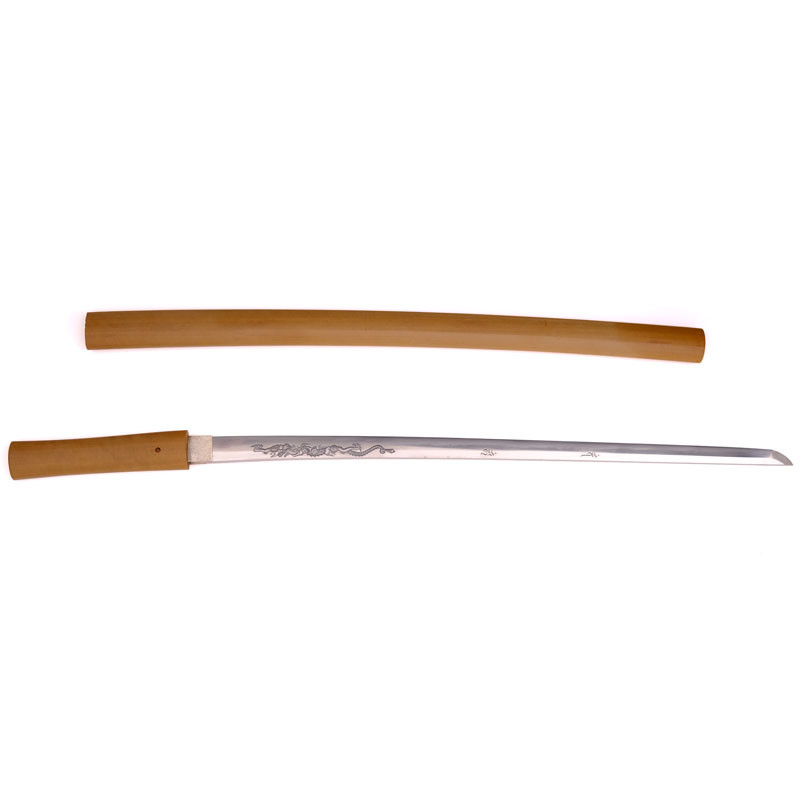


















More informations about this product
| Total Weight | 1.030 kg | |
| Weight without Saya | 0.768 kg | |
| Blade Weight | 0.654 kg | |
| Full Blade length (Toshin) | 86.70 cm | |
| Nagasa | 69.90 cm | |
| Nakago Length | 16.70 cm | |
| Sori (curvature) | 0.63 cm | |
| Kissaki Length | 2.80 cm | |
| Moto Haba | 3.17 cm | |
| Saki Haba | 1.92 cm | |
| Moto Kasane | A = 0.75 cm B= 0.72 cm |
|
| Saki Kasane | A = 0.49 cm B = 0.50 cm |
|
| Curvature | Tori Sori (Curvature on the 1st Third) very low | |
| Type Kissaki | Chu Kissaki | |
| Blade Structure | Shinogi Zukuri (diamond shaped) | |
| Horimono | On the face Omote: Kudari Tamaoi Ryu 降り玉追い龍 Dragon descending from the sky, and Bonji (Dainichi Nyorai and Fudo Myo) Ura: Sankozuka No Ken 三鈷柄, and Bonji (Bishamonten) |
|
| Mune | Iori Mune (triangular) | |
| Hamon | Yakidashi at the beginning of the blade, then Sudareba active in Nie Deki | |
| Hada | Ko Itame Hada | |
| Boshi | Ko Maru Kaeri | |
| Nakago | Ubu, Signed 丹波守吉道 “Tamba No Kami Yoshimichi” on Omote face, with Kiku (Imperial Chrysanthemum), 2 Menuki Ana, Classical form Futsu Gata, Yasurime Sujikai, End in Iriyamagata Jiri (dissymmetric V). | |
| Saya | Weight 260g, Length 74.00cm, Saya shirasaya in Magnolia | |
| Tsuka & Tosogu (Tsuba, Menuki, Fuchi Kashira) |
- Tsuka: Weight 76g, length 20.6 cm, Shirasaya Tsuka in Magnolia -Habaki: Silver Habaki with oblique Nego Gaki all over the surface |
|
| Study & Team Review |
The Yoshimichi 吉道 blacksmith line originated from the Mishina 三品 school in Mino, founded by Kaneuji 兼氏 in the 14th century. This school was strongly influenced by the tradition of Soshu because Kaneuji was one of the ten students of Masamune. The Yoshimichi lineages of the Shinto era are well-known and well-known for the invention of the Hamon Sudareba 簾刃 using the pattern of the bamboo curtains, made from Sunagashi. The blade presented is a realization of Tamba No Kami Yoshimichi of Kyoto 3rd generation. By his civil name Mishina Tokuzaemon, Yoshimichi 3rd gen. was forging around the Kanbun era, circa 1660. He obtained the honorary title of «Tanba No Kami» in 1662 and like the Yoshimichi of Kyoto, he engraved the imperial chrysanthemum above his signature. We have few blades of this generation because he did not live long. Because of the excellence of its forge and their rarity, the blades of Kyo Yoshimichi 3rd Gén are very appreciated by collectors. The Mishina 三品 School was imported from Seki (Mino) to Kyoto by Kanemichi 兼道 (9thGen Kaneuji) in 1593, with his 4 sons, Iga no Kami Kinmichi (伊 賀 守 金 道),Echigo No Kami Rai Kinmichi (越 後 守 来 金 道), Tanba no Kami Yoshimichi (丹波守吉道), Etchu no Kami Masatoshi (越中守正俊). This Mishina school in Kyoto, is characterized by 4 main currents, Kyo Tamba No Kami, Osaka Tamba No Kami, Fushimi Tamba No Kami, and Yamato No Kami. As mentioned above, Kanemichi’s best-known forging son is Tamba No Kami Yoshimichi 1st Gen of Kyoto, who created the beautiful Sudareba hamon based on Sunagashi line overlay parallel to the cutting edge. Tamba’s first son No Kami Yoshimichi 1st Gen became the 2nd generation of Kyoto, and the second son, Mishina Kaneuemon, moved to Osaka to create the Tamba No Kami branch of Osaka as 1st generation. This Osaka lineage was also excellent and had the honorary title of «Tamba No Kami» in 1644. However, unlike the Kyoto lineage, they did not engrave the imperial chrysanthemum. Finally, the second son of the 1st generation Yoshimichi of Osaka also created his current under the title of Yamato No Kami Yoshimichi. This blade from Kyo Tamba No Kami Yoshimichi 3rd generation is therefore a quite exceptional piece, and a perfect example of the achievements of this lineage. Embellished with Horimono (engraving) of very high quality, the rendering is sumptuous. These Horimono are not from this blacksmith because he was not used to make them on his blades. These are Horimonos added after to embellish this beautiful piece. Here are their meanings:
|
|
Share your opinion
error Your review appreciation cannot be sent
feedback Report comment
check_circle Report sent
error Your report cannot be sent